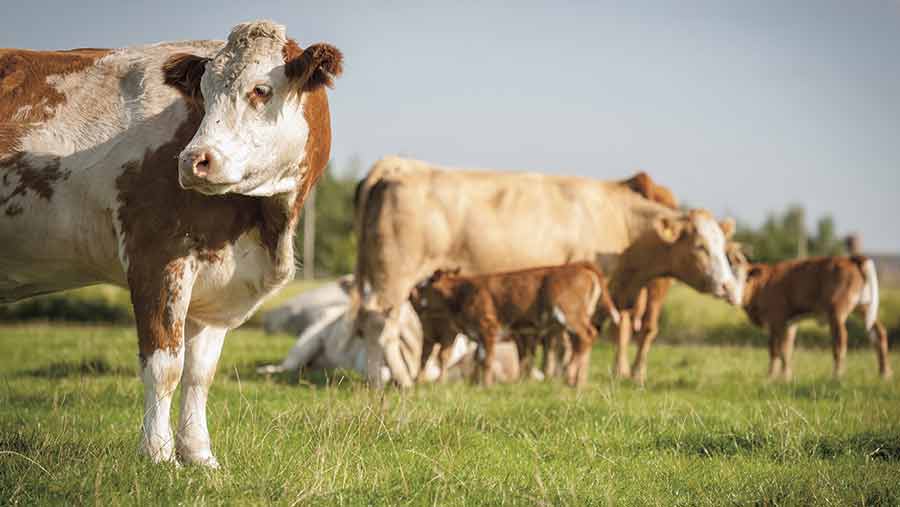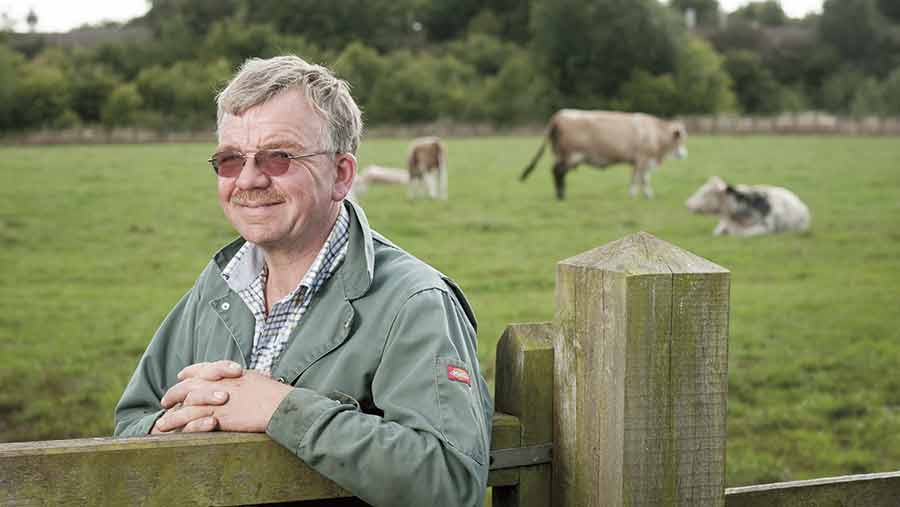Beef Focus Farm: How reducing waste is maximising beef margins
Margins at Williamswood Farm, Nottinghamshire, are dictated by changes in farm management and not in beef price, says Harper Adams Beef Focus Farmer Ian Willison.
He believes that farm output is something he has a degree of control over, unlike market volatility, and that rearing 98.8% of calves born each year from high EBV (or Index) bulls is paramount to having a margin in the beef industry.

© Jim Varney
Currently, gross margin stands at £804 for every cow in his autumn calving Simmental-cross Blue suckler herd, some 63% ahead of the English average.
See also: How cow size influences performance at Williamswood
This level of achievement hinges on low mortality, efficient feeding and a practical system for the given environment, which for Mr Willison is based around investment in the “golden triangle” of genetics, health and nutrition.
Vaccinations and replacement rearing are therefore not strictly seen as costs, explains Mr Willison, who regularly scrutinises his business on a cost of production basis.
Instead, money spent on vaccines and replacements is seen as an investment and a critical part of the most important figure on the accounts sheet – financial performance a cow.
“I don’t like to see mortality increase,” stresses Mr Willison, who is part of the Biobest health scheme, under which the farm is accredited for BVD, IBR, Neospora and Johne’s.
“The scheme’s had a massive impact in keeping mortality to a minimum. It is worth £5,000 a year in benefits and costs around £1,000, so it’s a no-brainer,” he adds.
Also important is the ability to maximise the beef cheque by hitting abattoir specifications and this requires an eye on the marketplace and finding premium outlets for heifers.
Last year’s silage and blend-finished bull calves yielded carcass weights of 398kg at 13.3 months old, meaning daily carcass gains from birth were 0.98kg and DLWG from birth to slaughter averaged 1.68kg.
Five-year rolling costs
Farm accounts and business benchmarking are seen as a critical step in managing what is going on at farm level – the element over which a farmer has most control, stresses Mr Willison.

© Jim Varney
He values the insight of “people on the outside”, who can draw on experience of other farms and enterprises to give an objective opinion.
“I use a specialist livestock consultant who does costings for several beef and sheep farms,” explains Mr Willison.
“Richard Elliot does a five-year rolling gross margin comparison, this is really useful as it benchmarks one year against another to see where we are progressing.”
The business has seen a steady increase in margin over the last five to 10 years.
“It’s vital on two counts; it shows what is working and importantly what is holding the business back and nine times out of ten margin falters not because of the price of beef in the market but because of something going awry on the farm.”
Knowing cost of production allows Mr Willison to appreciate the year’s margins can lift, despite fat cattle prices dropping. It could be due to gains in productivity, or falling feed costs.
“We’ve had lower feed and diesel costs over the past year or so and we can see how this has played out by sitting down and looking at the five-year costings, which are simply represented in five columns side by side.
Mistakes that resulted in lower margins
“We’ve had a few blips,” admits Mr Willison. “One year I tried cutting costs by mixing apple pomace in the bull ration. We were running low on barley and against the advice of my feed merchant I gave it a try. The end result was poor and I didn’t achieve the same kill out percentage.
“Another year our cows weren’t stacking up as well as they had been on paper. This was flagged up by the five-year analysis Richard does and we found that calf mortality had increased and fertility [was impacted].
See also: Tips for achieving one calf per cow every year
“That said, if I make a change and it pays performance-wise, then I’m not worried about the added expenditure. I believe you only get out what you put in.
“Now if I tweak my system and add in a few more cows, probably ending up with no more than 95-100-head overall, it might be interesting to see where margin and farm profit will head.”
Table 1. Williamswood suckler herd margins
|
AHDB rearer/finisher |
|
||
|
Financial performance (£ per cow) |
Average |
Top 1/3rd |
Ian Willison |
|
Calf output |
1,013 |
1,084 |
1,298 |
|
Replacement costs (incl incoming calves) |
52 |
47 |
80 |
|
Output less replacement costs |
961 |
1,037 |
1,218 |
|
Variable costs |
|||
|
Purchased feed inc minerals |
181 |
117 |
136 |
|
Home-grown feed |
50 |
43 |
37 |
|
Purchased forage |
18 |
29 |
0 |
|
Home-grown forage variable costs |
73 |
45 |
82 |
|
Total feed and forage |
322 |
235 |
255 |
|
Vet and med |
44 |
34 |
43 |
|
Bedding |
61 |
58 |
55 |
|
Other livestock expenses |
42 |
43 |
61 |
|
Total variable costs |
469 |
370 |
414 |
|
Gross margin/cow |
492 |
667 |
804 |
Source: Richard Elliot, Livestock & Business Consultant
Profit is in the waste
A 32-horse livery yard and rented shed space for caravan storage are sideline enterprises to the expanding suckler operation, with cow numbers currently hitting 93 head.
Fixed costs are split 60:40 (60% cows: 40% livery yard) because all equipment is used to the benefit of both enterprises, barring the cattle-only feeder wagon and bedding machine.
Mr Willison is considered full-time on the farm and his wife Lorraine manages the stables.
Integrating the livery yard and the cows is key to making sure money spent is not wasted and this starts with bedding.
Straw is sold into the equestrian unit, used by the horses, and then recycled as cattle bedding the following day.
Waste is also reduced within the beef unit by feeding a TMR ration, which minimises forage waste compared to ring-feeding silage.
“With bedding and feed it’s already cost you to produce or buy it, so don’t waste it,” says Mr Willison advises.
Things you can’t do the job without
In terms of machinery, several purchases over the past three years have increased labour efficiency on-farm but eroded farm margins, admits Mr Willison.
In growing the herd from 75 to over 90-head since 2013, the justification has been that one front-end loader and one 100hp tractor for the farm and the stables was stretching it a bit far – something had to give.
Top tips from Simon Marsh
- View replacement costs as an investment
- Concentrate on cow genetics as much as the bull
- Join a health scheme
- Make sure all enterprises dovetail
- Justify investment in machinery to significantly improve efficiency
- Think “health, nutrition and genetics” – a weakness in one and the others will suffer
- Profit follows adopting the “science of beef production”. Be wary of the “smoke and mirrors” in the beef industry
“It was wearing both me and the tractor out,” says Mr Willison, who added a feeder wagon, a bedding machine and a second 100hp tractor, with the fixed costs of the loader and two tractors shared across the beef and livery businesses.
“Adding to my machinery saves my time as I’m not swapping machinery around and it means the tractors will last longer.”
The £10,000 feeder wagon cuts feed waste, meaning output can be increased from having more cows and was traded in for a £3,000 mill and mix unit, which was rotting in the sheds.
Another justification for the feeder was the fact that other fixed costs, such as the tractors, can be shared over two enterprises, says Harper Adams University beef specialist Simon Marsh.
“The good cashflow of both enterprises allows investment sooner and with less finance than would be the norm,” details Mr Marsh.
“The livery side enjoys the use of machinery and labour from the cow side to make hay, cart straw, remove muck and do all other field work.”
This is why costs are shared the way they are, he adds. “Cows shouldn’t carry the rent, water, contracting costs on their own. And, in terms of machinery investment, which Ian views as a liability and not an asset, this is a cost but it reduces labour costs.”
Accounting for high performance
Exceptional bull calf performance is also a major factor in achieving a gross margin of £804 per cow at Williamswood, explains Mr Marsh.
Farm records show the 13.3 month-old Simmental-cross bulls gross £1,378 and non-retained heifers make £1,300 at 15 months when sold to pedigree breeders for embryo transfer work.
The same valuation has to be placed on his homebred 22 to 23-month calved replacement heifers. However, this makes replacement costs look steep at £80 a cow compared with AHDB figures levelling at £50 a cow.
Meanwhile, because of the attention to detail with feeding, feed and forage costs may look high, but Mr Marsh stresses this is producing bulls at 398kg carcass weight (48kg above the AHDB target), which is worth £158 a bull at £3.30/kg dwt (dead carcass weight).
See also: Mr Willison’s management and ration options to hit tighter carcass specification
In terms of bedding, the £55 figure is “very debateable” but a bone of contention for the beef sector.
“I would argue that most suckler farms should be on a ‘straw for muck’ agreement and therefore have zero bedding costs,” says Mr Marsh.
“And in terms of mixed units, why should the arable land on a mixed farm get free farm yard manure from the beef operation? Also of concern are the diminishing organic matter levels in soil, which can be helped by cattle in a rotation, along with controlling blackgrass.”
Table 2. 2015 calving performance
|
Birth wt (kg) |
47.1 |
|
Calving Ease (1-6) |
1.28 |
|
200 day wt (kg) |
335 |
|
DLWG (kg) |
1.44 |
|
Cow wt (kg) |
667 |
|
Efficiency (kg calf/100kg cow wt) |
50.2 |
Calving ease score: 1 = unassisted, 6 = cesarean
